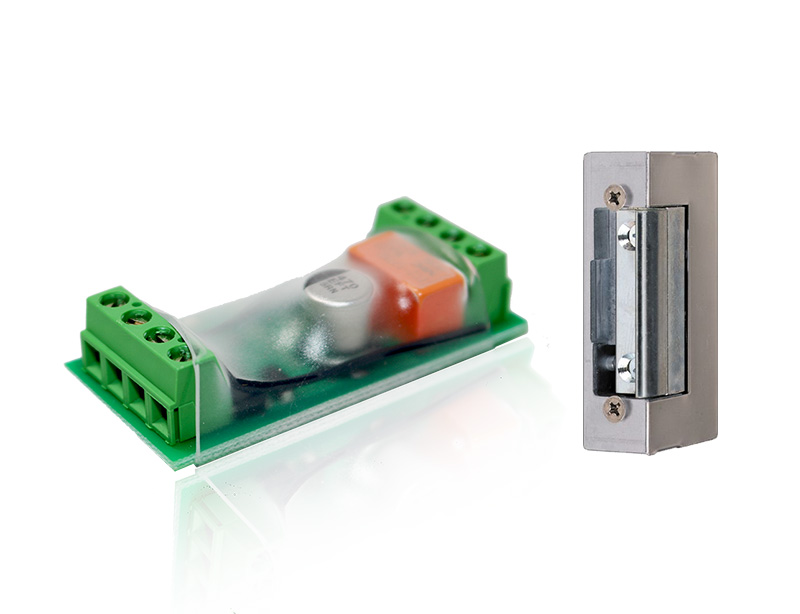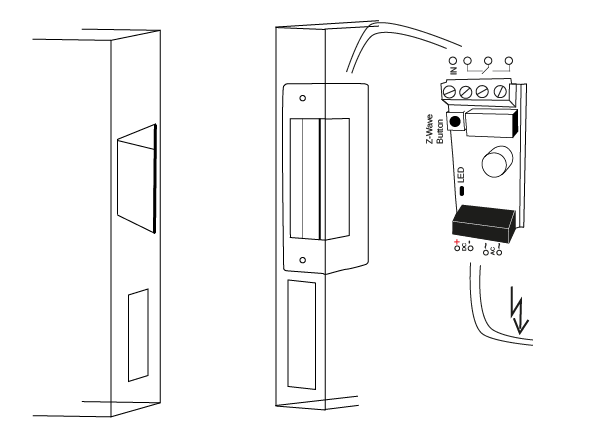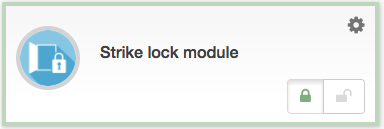
Popp
Strike Lock Control
SKU: POPE012501



Quickstart
This is a
Important safety information
Please read this manual carefully. Failure to follow the recommendations in this manual may be dangerous or may violate the law. The manufacturer, importer, distributor and seller shall not be liable for any loss or damage resulting from failure to comply with the instructions in this manual or any other material. Use this equipment only for its intended purpose. Follow the disposal instructions. Do not dispose of electronic equipment or batteries in a fire or near open heat sources.Product Description
This electric Strike Lock control is a Security Enabled Z-Wave Plus Product. An Security Enabled Z-Wave Controller must be used to fully utilize this product. An electric strike is an access control device used to lock and release doors. Electric strikes are installed in or on the doorframe and work in conjunction with mechanical door lock, on the principle of electronically controlling the rotation of the keeper allowing for door opening without manual retraction of the mechanical door lock. This product combines a 16 mm thick strike lock (that will fit into almost all door formats) with a Z-Wave plus empowered wireless control. The lock mechanics and the Z-Wave control are operated by a 9V block battery or an external 8-12V AC / 8-24V DC transformer. The Z-Wave control accepts commands to open or close the strike. Depending on the configuration of the DoorLock CC, the door will be locked automatically after a certain time even if no ‘close? command was sent.
The device can be used standalone and within every conventional Intercom system controlling strike locks.
Installation
The Strike-Lock has a IP 20 protection class, hence it is not recommended to install the device directly outdoors. Depending in its power situation the device will either act as Z-Wave repeater or as so-called FLiRS-device (frequently listening battery operated). Any voltage > 12 V DC is detected as mains powered; any voltage <= 9 V is detected as battery operated using the 9 V battery block.
There are four possible scenarios you want to install the Strike-Lock. It is highly recommended to test the electrial wiring and setup prior to making any change on the mechanical door.
No existing installation of an electrical door opener and no AC power on the spot
In this case you will have to mechanically install the strike lock of your choice, find a place for the battery and the strike lock control nearby and implement the wiring as shown below:
No existing installation of an electrical door opener but dedicated AC Power on the spot
You may find AC power on the spot if the door is near a traditional door bell button that is powered by a conventional transformer. In this case you will have to install the mechanican strike look and find a dry place for the strike lock control. The distance between the transformer and the strike lock control and between the strike lock control and the strike depends on the qulity of the transformer and the quality of the wires used. You may orientate on the distances between the existing door bell button and the transformer (usually placed inside the mains distibution panel).
Existing traditional analog door bell installation
Existing door bell installations usually connect the door bell button and the bell using two wire cables to the mains distribution panel where the AC transformer is placed. The image below shows how to change this existng cabling to power the strike lock in parallel.
Existing (multi user) Intercom system with integrated door opener
Most multi-floor appartment houses are equipped with an audio communication between the main door and the appartments to identify visitors. Such a system usually contains a way to open the mains door using a button on the Intercom system. Communication between the different terminals inside the appartments and a central control are of proprietary nature. The strike lock is then controlled from the central controller device using two dedicated wires.
The Popp Strike lock can be used in such an installation independend of the type of the Intercom solution and without interfering the existing Intercom infrastructure. The image below shows the required wiring. The system will with both battery operation and AC power supply (image shows battery solution only).
Mechanical Installation of the Strike Lock (if needed)
- Remove the existing door plate by unscrewing it with your screwdriver. Be careful not to strip the screws as this will make removal much more difficult. Now you have two options. Either you find a plate that already has the cut-outs to fit the strike lock or you have to cut your existing plate to accommodate the strike lock. The strike lock is connected to the door strike using two screws in a distance of 55 cm. This is a standardized distance and the two holes should already be available on almost all plates in the market. If they are not available you have to drill two holes of diameter of 4 mm in equal distance from the cut out that accommodates the door latch. The cut-out can be done using a simple metal saw or a Dremel.
- The next step is to make sure there is enough room behind the plate so that the look fits in. Our strike look is particularly small so the required space allocation is only 16,6 mm width and 26 mm deep.
- Now you will need to decide where to place the control electronics. You can place it near the strike using short wires or place is next to your power supply using longer wires.
Dry Input Handling
The strike lock control has one dry input terminal marked as "IN". This can be used to indicate if a door is opened or closed by connecting it to DC ground utilizing a simple external switch. Some third party strike locks offer so-called monitoring contact exactly delivering this function. Having a monitor contact on a strike lock or any other mechanical contact will save the need for an additional wireless door contact to monitor the status of the door. Whenever the door is open the strike magnet is not powered anymore to save energy. The strike magnet is also unpowered immediately when an opening door is detected. Events from the dry inout can control other Z-Wave devices using BASIC command class and association group 2. The configuation parameters 1 and 2 define the BASIC commands used.
Product Usage
The strike lock control allows opening doors using a strike lock. It is recommended to use the device together with a Z-Wave door sensor indicating the status of the door resp. using an external dry contact to serve the same purpose. According to Z-Wave policies the wireless control of the door lock is allowed with secure Door Lock commands only.
The Popp Hub central controller offers a App from the App store that combines both functions into one element showing the three states of a door (open, close and locked, close but unlocked) and allows ot control the strike lock. Of course any other third party software or central Z-Wave controller can operate the door lock as well.
Some estimation on battery life
The strike lock control itself only needs about 50 yA of power. An 9 V lithium battery block will last more than 4 years. The operation of a strike lock however costs energy. Just assume 5 (5 second long) operations per day will drain the battery in about one year.
Notifications
The device will send the following notifications to the central controller:
- Battery Status (Battery Command Class Report)
- External Dry Contact on/off (Notification Type 0x06 with events open=0x16 and closed=0x17)
- Door Lock Open/Close (Door Lock Command Class Report)
- Local Device Reset (Device Reset Locally Command Class Report)
| Reset to factory default | To do a factory reset press the Z-Wave button on the bottom of the device for at least 10 seconds. |
| Inclusion | 1. Connect the device as described.
2. Press the button for one second. |
| Exclusion | 1. Press the button for one second. |
| NIF | A single click on the button will issue a NIF. The type of the NIF depends on the powering situation. In cas the device detects to me mains operated the NIF is inform the controller that this device is routing and always wirelessly active. In case battery operation is detected the NIF will contain this information (its a FliRS). |
| Wakeup | XXXWakeupDescription |
| Protection | XXXProtection |
| FirmwareUpdate | Once the firmware update process has started double click the Z-Wave button to confirm firmware update process. |
| SetAssociation | XXXSetAssociation |
Association Groups:
| Group Number | Maximum Nodes | Description |
|---|---|---|
| 1 | 10 | Lifeline |
| 2 | 10 | External Dry Contact |
Configuration Parameters
Parameter 1: Value of OPEN-Command
This parameter defines the value of the BASIC Set command issued into association group 2 when the dry contact opens. Size: 1 Byte, Default Value: 0
| Setting | Description |
|---|---|
| 0 - 99 | Command Value |
Parameter 2: Value of CLOSE-command
This parameter defines the value of the BASIC Set command issued into association group 2 when the dry contact closes. Size: 1 Byte, Default Value: 99
| Setting | Description |
|---|---|
| 0 - 99 | Command Value |
Parameter 5: Force FliRS Mode
Size: 1 Byte, Default Value: 0
| Setting | Description |
|---|---|
| 0 | Depends on Power Status in Inclusion Moment |
| 1 | Force FLiRS Mode |
Technical Data
| Dimensions | 56x25x14 mm |
| Weight | 20.31 gr |
| Hardware Platform | ZM5202 |
| EAN | 0019962012501 |
| IP Class | IP 20 |
| Voltage | 8-12V AC / 8-24V DC |
| Battery Type | 1 * 9V Block |
| Device Type | Door Lock |
| Network Operation | Listening Slave |
| Firmware Version | 1.5 |
| Z-Wave Version | SDK 6.51.09 |
| Certification ID | ZC10-17035482 |
| Z-Wave Product Id | 0x0154.0x0005.0x0001 |
| Frequency | Europe - 868,4 Mhz |
| Maximum transmission power | 5 mW |